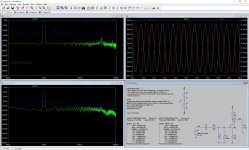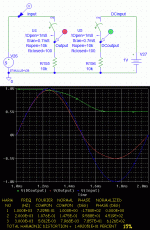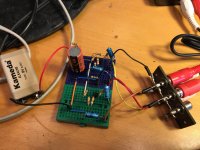Baldin, I do not have a chance to test NP's H2 board, but I have been experimenting digital saturation/ distortion plugins inserted on the playback chain for years. I posted a few notes about a free H2 plugin on the H2 thread, but it seems like no one else has tried it, nor no comment about NP's H2 boards distributed for free at BA2018 a few weeks ago.
You know why? It seems like Mr. Pass is claiming the sweet spot is 1% H2 at your average listing RMS level, but he is also saying it’s all depends on the user’s taste, amp and music source, and the user has to find the sweet spot by himself anyway.
If one starts to dial sweet spot for each disk in his given context, what he is doing is actually a mastering, and it’s very rare to find an audiophile who really wants to step into this God's Domain. The average audiophiles just want to have minimal distortion, or wants to hear distortion that “accidentally“ happens, not ”actively” happens. It's OK if the distortion was added at the production stage, because it is uncontrollable and is considered to be an accidents even if most of the distortion added at the production stage today is purposeful.
It is not about technology, but psychology.
BTW, with Audirvana + Tidal highRez streaming + plugin, you can hear the saturation / distortion effects for completely free at least for 30 days, so I would recommend to try it. SSL saturation plugin and the other high end plugins should be mostly free for 30 days as well, so you can hear different saturation / distortion flavor. I promise you’ll find interesting things. Enjoy!
You know why? It seems like Mr. Pass is claiming the sweet spot is 1% H2 at your average listing RMS level, but he is also saying it’s all depends on the user’s taste, amp and music source, and the user has to find the sweet spot by himself anyway.
If one starts to dial sweet spot for each disk in his given context, what he is doing is actually a mastering, and it’s very rare to find an audiophile who really wants to step into this God's Domain. The average audiophiles just want to have minimal distortion, or wants to hear distortion that “accidentally“ happens, not ”actively” happens. It's OK if the distortion was added at the production stage, because it is uncontrollable and is considered to be an accidents even if most of the distortion added at the production stage today is purposeful.
It is not about technology, but psychology.
BTW, with Audirvana + Tidal highRez streaming + plugin, you can hear the saturation / distortion effects for completely free at least for 30 days, so I would recommend to try it. SSL saturation plugin and the other high end plugins should be mostly free for 30 days as well, so you can hear different saturation / distortion flavor. I promise you’ll find interesting things. Enjoy!
Last edited:
Hi Plasnu
Yes think you are right
On the other hand audiophiles all over the world pay large amounts of money for SIT tube amps. These amps do exactly the same as the H2 circuit, adds distortion as the amp is nearing it's max output.
Have done some simulations in LTSpice, and have tweeket the circuit to give around -59 db at 0.1 Vpk input and raising to -39.5 db at 1 Vpk input.
I would have liked to get the little preamp to also give a littele amplification of 3x, but have not ben able to get this with the same distortion figures.
I have also simulated with other jfets, but J112 seems to be a very good candidate which is still available videly (not obsolete like most audio jfets)
Have ordered some, and will try it out soon in real life
Adding this to a good class-d amp, and you'll have SIT sound but with a lots of watts
Yes think you are right
On the other hand audiophiles all over the world pay large amounts of money for SIT tube amps. These amps do exactly the same as the H2 circuit, adds distortion as the amp is nearing it's max output.
Have done some simulations in LTSpice, and have tweeket the circuit to give around -59 db at 0.1 Vpk input and raising to -39.5 db at 1 Vpk input.
I would have liked to get the little preamp to also give a littele amplification of 3x, but have not ben able to get this with the same distortion figures.
I have also simulated with other jfets, but J112 seems to be a very good candidate which is still available videly (not obsolete like most audio jfets)
Have ordered some, and will try it out soon in real life
Adding this to a good class-d amp, and you'll have SIT sound but with a lots of watts
Attachments
Adding this to a good class-d amp, and you'll have SIT sound but with a lots of watts
I tested digital H2 plugins with digital amp (Icepower). It's great and I currently keep inserting one for my living room set.
I also have SIT SE amp (L'amp). I have not compared ClassD+H2 VS SIT directly, but ClassD+H2 and SIT would not sound exactly the same, because SIT SE has very low damping factor (and some other measurable difference). I'm curious, so I would do AB test in the future.
And distortion, both linear and non linear
What is "linear distortion" please?
If you apply a pure 1kHz sinewave (1.0V RMS amplitude) at the input of a "linear distortion" box, what is the output?
As Nelson Pass would say: "it's all entertainment"
Jan
Truer words were never spoken. A humbling statement in many ways.
What is "linear distortion" please?
If you apply a pure 1kHz sinewave (1.0V RMS amplitude) at the input of a "linear distortion" box, what is the output?
Linear distortion causes no new frequencies. It causes frequency and/or phase deviations.
Examples are filters, eq, reverb, delay, phasing, chorus, flanging, diffraction etc.
Non linear distortion causes new frequencies to be added to the signal.
Examples are compression, harmonic distortion, clipping, limiting etc. One of the results could be that inaudible low level sounds become audible.
To answer the last question, it depends, it could be higher in level, lower in level and/or phase shifted.
Last edited:
Linear distortion causes no new frequencies. It causes frequency and/or phase deviations.
Examples are filters, eq, reverb, delay, phasing, chorus, flanging, diffraction etc.
Non linear distortion causes new frequencies to be added to the signal.
Examples are compression, harmonic distortion, clipping, limiting etc.
To answer the last question, it depends, it could be higher in level, lower in level and/or phase shifted.
Thanks for your reply! Paragraph 3 makes me think that you accidentally made a typo in paragraph 1, where you wrote "frequency deviations" ; I suspect you actually meant amplitude deviations. Since "frequency deviation" causes new frequencies, by definition. But amplitude deviations will cause the output to be higher in level or lower in level than the input, satisfying paragraph 3.
An example of an amplitude deviation could be a voltage divider built from two resistors: amplitude out does not equal amplitude in. Same for an amplifier with a gain of 1.5X. Then there's the case of an amplifier with a gain of -1.5X ; it causes amplitude deviation and also phase deviation (180 degrees). I haven't seen this called "linear distortion" before now.
Linear distortion causes no new frequencies. It causes frequency and/or phase deviations.
Examples are filters, eq, reverb, delay, phasing, chorus, flanging, diffraction etc.
Non linear distortion causes new frequencies to be added to the signal.
Examples are compression, harmonic distortion, clipping, limiting etc. One of the results could be that inaudible low level sounds become audible.
To answer the last question, it depends, it could be higher in level, lower in level and/or phase shifted.
How does compression add frequencies? Does turning your volume control quickly cause new frequencies? Don't think so.
How does compression add frequencies? Does turning your volume control quickly cause new frequencies? Don't think so.
Turn repeatedly rapidly, it clearly does. Turn up/down/up/down 10 times a second, you have new tones 10Hz each side of your original tones. Tremolo.
Turn slowly, the new tones are negligibly small and close to the original tones, only while turning. Our brains do not notice this behind the obvious change of amplitude.
My simulator's "switch" actually fades from one resistance to another over non-zero time. By changing the defaults it will change from say 100r to 10k in say 0.7mS. I put this with a fixed resistor to make a variable attenuator. To help show the action a duplicate is fed DC.
We get 14%THD, but only for the 1mS while gain is changing.
If I stretch the transition to 10mS, and take the 5mS where it is changing fastest, it is 8%THD.
FWIW: audio limiters commonly attack in the 1mS to 10mS range. Longer times are used when initial transients are to be brutally clipped, as in drums for pop music. But a "clean" limiter *has* to act in the few mS before the ear can perceive "distorted".
Attachments
Thanks for your reply! Paragraph 3 makes me think that you accidentally made a typo in paragraph 1, where you wrote "frequency deviations" ; I suspect you actually meant amplitude deviations. Since "frequency deviation" causes new frequencies, by definition. But amplitude deviations will cause the output to be higher in level or lower in level than the input, satisfying paragraph 3.
An example of an amplitude deviation could be a voltage divider built from two resistors: amplitude out does not equal amplitude in. Same for an amplifier with a gain of 1.5X. Then there's the case of an amplifier with a gain of -1.5X ; it causes amplitude deviation and also phase deviation (180 degrees). I haven't seen this called "linear distortion" before now.
Yes, I should have said frequency spectrum deviations.
How does compression add frequencies? Does turning your volume control quickly cause new frequencies? Don't think so.
To add a bit more to the replies.
If you change linear distortion over time, you get non-linear distortion.
- Status
- This old topic is closed. If you want to reopen this topic, contact a moderator using the "Report Post" button.
- Home
- Member Areas
- The Lounge
- Is all distortion bad?


